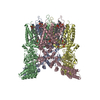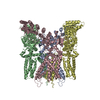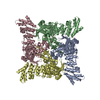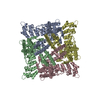+ Open data
Open data
- Basic information
Basic information
| Entry | Database: PDB / ID: 6lgp | |||||||||||||||||||||||||||||||||||||||||||||||||||||||||||||||||||||||||||||||||||||||||||||||||||
|---|---|---|---|---|---|---|---|---|---|---|---|---|---|---|---|---|---|---|---|---|---|---|---|---|---|---|---|---|---|---|---|---|---|---|---|---|---|---|---|---|---|---|---|---|---|---|---|---|---|---|---|---|---|---|---|---|---|---|---|---|---|---|---|---|---|---|---|---|---|---|---|---|---|---|---|---|---|---|---|---|---|---|---|---|---|---|---|---|---|---|---|---|---|---|---|---|---|---|---|---|
| Title | cryo-EM structure of TRPV3 in lipid nanodisc | |||||||||||||||||||||||||||||||||||||||||||||||||||||||||||||||||||||||||||||||||||||||||||||||||||
 Components Components | Transient receptor potential cation channel subfamily V member 3 | |||||||||||||||||||||||||||||||||||||||||||||||||||||||||||||||||||||||||||||||||||||||||||||||||||
 Keywords Keywords | MEMBRANE PROTEIN / TRP channel / TRPV family / TRPV3 / nanodisc | |||||||||||||||||||||||||||||||||||||||||||||||||||||||||||||||||||||||||||||||||||||||||||||||||||
| Function / homology |  Function and homology information Function and homology informationnegative regulation of hair cycle / TRP channels / response to temperature stimulus / positive regulation of calcium ion import / sodium channel activity / monoatomic ion channel activity / monoatomic cation channel activity / calcium channel activity / lysosome / receptor complex ...negative regulation of hair cycle / TRP channels / response to temperature stimulus / positive regulation of calcium ion import / sodium channel activity / monoatomic ion channel activity / monoatomic cation channel activity / calcium channel activity / lysosome / receptor complex / metal ion binding / identical protein binding / membrane / plasma membrane / cytoplasm Similarity search - Function | |||||||||||||||||||||||||||||||||||||||||||||||||||||||||||||||||||||||||||||||||||||||||||||||||||
| Biological species |  | |||||||||||||||||||||||||||||||||||||||||||||||||||||||||||||||||||||||||||||||||||||||||||||||||||
| Method | ELECTRON MICROSCOPY / single particle reconstruction / cryo EM / Resolution: 3.3 Å | |||||||||||||||||||||||||||||||||||||||||||||||||||||||||||||||||||||||||||||||||||||||||||||||||||
 Authors Authors | Shimada, H. / Kusakizako, T. / Nishizawa, T. / Nureki, O. | |||||||||||||||||||||||||||||||||||||||||||||||||||||||||||||||||||||||||||||||||||||||||||||||||||
 Citation Citation |  Journal: Nat Struct Mol Biol / Year: 2020 Journal: Nat Struct Mol Biol / Year: 2020Title: The structure of lipid nanodisc-reconstituted TRPV3 reveals the gating mechanism. Authors: Hiroto Shimada / Tsukasa Kusakizako / T H Dung Nguyen / Tomohiro Nishizawa / Tomoya Hino / Makoto Tominaga / Osamu Nureki /  Abstract: Transient receptor potential vanilloid subfamily member 3 (TRPV3) is a temperature-sensitive cation channel. Previous cryo-EM analyses of TRPV3 in detergent micelles or amphipol proposed that the ...Transient receptor potential vanilloid subfamily member 3 (TRPV3) is a temperature-sensitive cation channel. Previous cryo-EM analyses of TRPV3 in detergent micelles or amphipol proposed that the lower gate opens by α-to-π helical transitions of the nearby S6 helix. However, it remains unclear how physiological lipids are involved in the TRPV3 activation. Here we determined the apo state structure of mouse (Mus musculus) TRPV3 in a lipid nanodisc at 3.3 Å resolution. The structure revealed that lipids bound to the pore domain stabilize the selectivity filter in the narrow state, suggesting that the selectivity filter of TRPV3 affects cation permeation. When the lower gate is closed in nanodisc-reconstituted TRPV3, the S6 helix adopts the π-helical conformation without agonist- or heat-sensitization, potentially stabilized by putative intra-subunit hydrogen bonds and lipid binding. Our findings provide insights into the lipid-associated gating mechanism of TRPV3. | |||||||||||||||||||||||||||||||||||||||||||||||||||||||||||||||||||||||||||||||||||||||||||||||||||
| History |
|
- Structure visualization
Structure visualization
| Movie |
 Movie viewer Movie viewer |
|---|---|
| Structure viewer | Molecule:  Molmil Molmil Jmol/JSmol Jmol/JSmol |
- Downloads & links
Downloads & links
- Download
Download
| PDBx/mmCIF format |  6lgp.cif.gz 6lgp.cif.gz | 463.5 KB | Display |  PDBx/mmCIF format PDBx/mmCIF format |
|---|---|---|---|---|
| PDB format |  pdb6lgp.ent.gz pdb6lgp.ent.gz | 382.4 KB | Display |  PDB format PDB format |
| PDBx/mmJSON format |  6lgp.json.gz 6lgp.json.gz | Tree view |  PDBx/mmJSON format PDBx/mmJSON format | |
| Others |  Other downloads Other downloads |
-Validation report
| Summary document |  6lgp_validation.pdf.gz 6lgp_validation.pdf.gz | 1.9 MB | Display |  wwPDB validaton report wwPDB validaton report |
|---|---|---|---|---|
| Full document |  6lgp_full_validation.pdf.gz 6lgp_full_validation.pdf.gz | 2 MB | Display | |
| Data in XML |  6lgp_validation.xml.gz 6lgp_validation.xml.gz | 77.7 KB | Display | |
| Data in CIF |  6lgp_validation.cif.gz 6lgp_validation.cif.gz | 113.4 KB | Display | |
| Arichive directory |  https://data.pdbj.org/pub/pdb/validation_reports/lg/6lgp https://data.pdbj.org/pub/pdb/validation_reports/lg/6lgp ftp://data.pdbj.org/pub/pdb/validation_reports/lg/6lgp ftp://data.pdbj.org/pub/pdb/validation_reports/lg/6lgp | HTTPS FTP |
-Related structure data
| Related structure data |  0882MC M: map data used to model this data C: citing same article ( |
|---|---|
| Similar structure data | |
| EM raw data |  EMPIAR-10400 (Title: Cryo-EM structure of mouse TRPV3 in a nanodisc / Data size: 2.1 TB EMPIAR-10400 (Title: Cryo-EM structure of mouse TRPV3 in a nanodisc / Data size: 2.1 TBData #1: Unaligned movies for mouse TRPV3 in a nanodisc [micrographs - multiframe]) |
- Links
Links
- Assembly
Assembly
| Deposited unit | 
|
|---|---|
| 1 |
|
- Components
Components
| #1: Protein | Mass: 73949.867 Da / Num. of mol.: 4 Source method: isolated from a genetically manipulated source Source: (gene. exp.)   Homo sapiens (human) / References: UniProt: Q8K424 Homo sapiens (human) / References: UniProt: Q8K424#2: Chemical | ChemComp-POV / ( #3: Chemical | ChemComp-PLC / Has ligand of interest | Y | Has protein modification | N | |
|---|
-Experimental details
-Experiment
| Experiment | Method: ELECTRON MICROSCOPY |
|---|---|
| EM experiment | Aggregation state: PARTICLE / 3D reconstruction method: single particle reconstruction |
- Sample preparation
Sample preparation
| Component | Name: TRPV3 / Type: ORGANELLE OR CELLULAR COMPONENT / Entity ID: #1 / Source: RECOMBINANT |
|---|---|
| Molecular weight | Experimental value: NO |
| Source (natural) | Organism:  |
| Source (recombinant) | Organism:  Homo sapiens (human) Homo sapiens (human) |
| Buffer solution | pH: 7.4 |
| Specimen | Conc.: 2 mg/ml / Embedding applied: NO / Shadowing applied: NO / Staining applied: NO / Vitrification applied: YES |
| Specimen support | Grid material: COPPER/RHODIUM / Grid mesh size: 300 divisions/in. / Grid type: Quantifoil R1.2/1.3 |
| Vitrification | Instrument: FEI VITROBOT MARK IV / Cryogen name: ETHANE / Humidity: 100 % / Chamber temperature: 279 K |
- Electron microscopy imaging
Electron microscopy imaging
| Experimental equipment |  Model: Titan Krios / Image courtesy: FEI Company | ||||||||||||||||
|---|---|---|---|---|---|---|---|---|---|---|---|---|---|---|---|---|---|
| Microscopy | Model: FEI TITAN KRIOS | ||||||||||||||||
| Electron gun | Electron source:  FIELD EMISSION GUN / Accelerating voltage: 300 kV / Illumination mode: FLOOD BEAM FIELD EMISSION GUN / Accelerating voltage: 300 kV / Illumination mode: FLOOD BEAM | ||||||||||||||||
| Electron lens | Mode: BRIGHT FIELD | ||||||||||||||||
| Image recording |
|
- Processing
Processing
| Software | Name: PHENIX / Version: 1.16_3549: / Classification: refinement | ||||||||||||||||||||||||
|---|---|---|---|---|---|---|---|---|---|---|---|---|---|---|---|---|---|---|---|---|---|---|---|---|---|
| EM software | Name: PHENIX / Category: model refinement | ||||||||||||||||||||||||
| CTF correction | Type: PHASE FLIPPING AND AMPLITUDE CORRECTION | ||||||||||||||||||||||||
| Symmetry | Point symmetry: C4 (4 fold cyclic) | ||||||||||||||||||||||||
| 3D reconstruction | Resolution: 3.3 Å / Resolution method: FSC 0.143 CUT-OFF / Num. of particles: 106947 / Symmetry type: POINT | ||||||||||||||||||||||||
| Refine LS restraints |
|
 Movie
Movie Controller
Controller













 PDBj
PDBj








